Swimming World’s Top Five Aquatic Trends of 2021
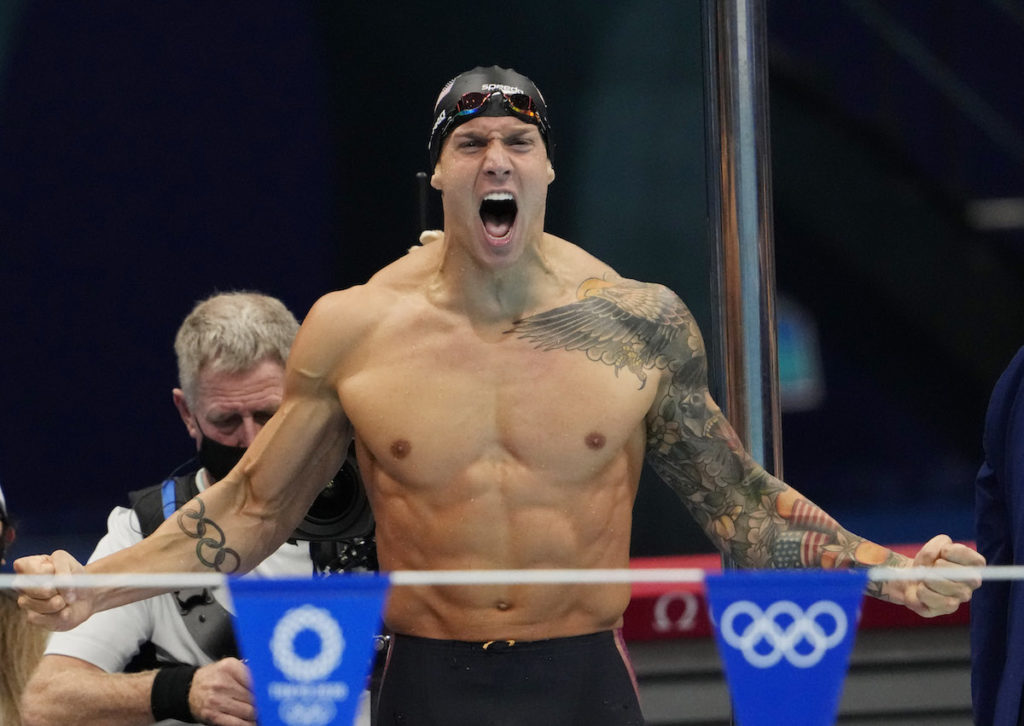
Swimming World’s Top Five Aquatic Trends of 2021
In 2020, the COVID-19 pandemic shut down the world in the middle of March, and swimming did not escape the wrath of the changes. The NCAA Championships were cancelled, and Olympics and each country’s Olympic Trials were postponed one year. Limited competition had returned by the end of the year, but it was only domestic meets and the International Swimming League, whose entire season was held inside a six-week bubble.
Thankfully for swimming fans, the sport was back in 2021, with a full slate of competition throughout the year. We saw new champions emerge and many amazing moments seared into the sport’s memory.
Here is a look back at the top five swimming trends of 2021.
1. Dressel and McKeon Emerge as Stars of Rescheduled Tokyo Olympics
Better late than never. The Olympics were rescheduled for 2021, but the spectacle of the sport at its pinnacle was as fascinating and exciting as ever. The men’s star of the Tokyo Games was Caeleb Dressel, who backed up dominant performances at the 2017 and 2019 World Championships with another one on the Olympic level. He captured individual gold medals in the 100 freestyle, 100 butterfly and 50 freestyle, becoming just the third man after Mark Spitz and Michael Phelps to win three individual golds in one Games. He also led the Americans to a pair of relay golds.
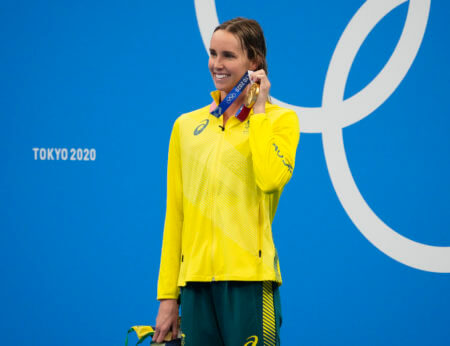
Australia’s Emma McKeon won seven medals at the Tokyo Olympics — Photo Courtesy: Robert Hanashiro/USA TODAY Sports
The top female performer was Emma McKeon, a 27-year-old Australian who broke the all-time record for medals by a female in one Olympics with seven. She was golden in the individual 100 freestyle and 50 freestyle along with a pair of relays. McKeon had familiar company as two other Aussies, Ariarne Titmus and Kaylee McKeown, took home two golds each. Titmus became the second-fastest performer ever in the 400 free and 200 free, while McKeown swept the 100 and 200 back.
Katie Ledecky made history in Tokyo as she won her third consecutive gold medal in the 800 free, becoming just the third woman to ever three-peat at the Olympics, and she also won gold in the inaugural women’s 1500 free. Meanwhile, superstar breaststroker Adam Peaty won his second consecutive gold in the men’s 100 breast, while Kristof Milak’s emergence continued with a gold in the 200 fly and silver in the 100 fly. Russia’s Evgeny Rylov was the double winner in the men’s backstroke events, and on the women’s side, Yui Ohashi was the star for her home country with wins in the 200 and 400 IM.
And of course, it would not be an Olympics without some major upsets. That’s what we saw in the men’s 800 free, when Bobby Finke was in fourth place and a second-and-a-half behind the top-three swimmers with 50 meters remaining. Then, he pulled off a surreal finish as he came all the way back to steal Olympic gold, and he pulled off the same feat three days later in the 1500 free. For the women, the top upset was in the 100 breaststroke, where 17-year-old Lydia Jacoby upset American teammate Lilly King, just months after she was a virtual unknown in the swimming world.
2. NCAA Championships Return, Virginia and Texas Win Titles
Prior to the cancellation of the 2020 NCAA Championships, the University of Virginia women and University of Texas men were favored to come away with the national titles. It turns out that both those teams were just as prepared in 2021, with the Cavalier women claiming their first title and the Longhorn men winning a 15th for legendary coach Eddie Reese.
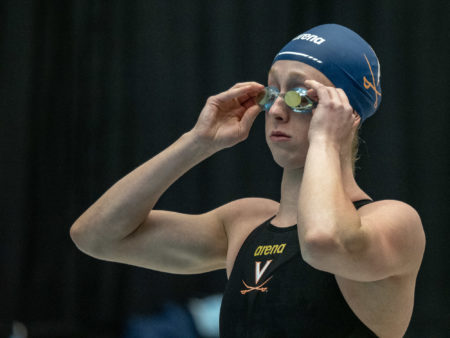
Virginia’s Paige Madden was the star of the women’s NCAA Championships — Photo Courtesy: Peter H. Bick
The 2021 championships were admittedly different than prior editions. Because of the COVID-19 pandemic, spectators were not allowed into the meet, and relays were switched to timed finals events with only four teams racing at a time, allowing an empty lane between each squad for social distancing. But as always at NCAAs, the racing was intense and the team competition fierce.
Virginia was led by senior Paige Madden, who claimed three individual wins in the 500 free, 200 free and 1650, while sophomore Kate Douglass won the 50 free and freshman Alex Walsh claimed first in the 200 IM. All three of those Virginia stars would end up qualifying for the U.S. Olympic team a few months later.
The Texas men did not capture any individual swimming titles and they won just two relays, but it proved to be enough for the Longhorns to eek out a 27-point win over longtime rival Cal. The stars for Texas include a pair of swimmers with runnerup finishes at NCAAs, Drew Kibler and Carson Foster.
The 2021-22 NCAA season is shaping up to be a fun one as well, with the Texas men looking practically unstoppable with most of their top performers returning and the Virginia women trying to hold off resurgent Stanford. Reese actually announced his retirement shortly after the meet, but he reconsidered a few months later, choosing to return to Texas and pursue a 16th national title. Meanwhile, the Cardinal added three Olympic medalists, Regan Smith, Torri Huske and Taylor Ruck, to its roster to set up an intense March showdown with the Cavaliers.
3. Following Controversy, ISL Season Finishes With Exciting Final
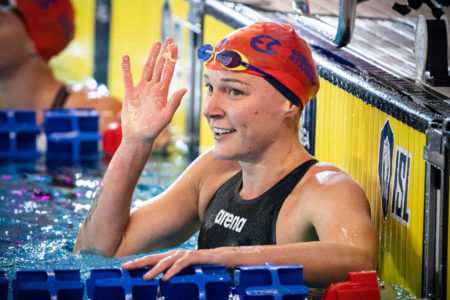
Sarah Sjostrom was the MVP of the 2021 ISL season — Photo Courtesy: Giorgio Scala / Deepbluemedia / Insidefoto
The 2021 ISL season began with a six-week stretch of meets in Naples, Italy, from late August through September, and it concluded with a three-week playoff round in November and then the Grand Final in early December in Eindhoven, Netherlands. The top teams quickly distinguished themselves from the pack, as Energy Standard, Cali Condors, London Roar and LA Current advanced to the final for the third straight season, but there was nearly some controversy along with the way.
Shortly before the playoffs began, news emerged that one team was considering a boycott because of late or missed payments from the league stretching back to the 2020 season. Numerous athletes confirmed that they had been paid much later than expected, but all issues were resolved in time for the playoffs to begin.
By far the most exciting match was the Grand Final, when the previous two league champions, Cali and Energy, went head-to-head. Cali got a world record from Kelsi Dahlia in the women’s 100 fly and wins from Caeleb Dressel, Lilly King, Nic Fink and Beata Nelson, but King was disqualified on the 400 medley relay, opening the door for Sarah Sjostrom and Siobhan Haughey to lead Energy Standard to the championship in an exciting finish.
4. Elite Swimming Around the World
The United States remains the foremost national power in swimming, while Australia returned to its former glory with a dominant performance in the women’s events at the Tokyo Olympics. But global swimming has expanded to unfamiliar territory, particularly with the performance of three swimmers on the world stage in 2021.
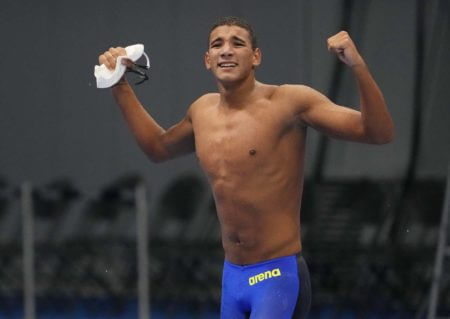
Tunisia’s Ahmed Hafnaoui was a stunning gold medalist in the men’s 400 free — Photo Courtesy: Rob Schumacher/USA TODAY Sports
First, Tunisia’s Ahmed Hafnaoui won a stunning Olympic gold medal in the 400 free, crushing his best time and winning from lane eight. The 18-year-old became his country’s second Olympic medalists after Ous Mellouli. A few months later, he returned to the spotlight at the Short Course World Championships, and while he did not make the 400 free final, he took silver in the 1500 free.
On the women’s side, South Africa had not won an Olympic medal in women’s swimming since 2000, and no South African woman had won gold since 1996. No South African woman even competed in swimming at the 2016 Olympics. But in Tokyo, Tatjana Schoenmaker captured gold in the 200 breast and broke the world record, becoming the first woman ever under 2:19 in the process.
Then there’s Siobhan Haughey, a former University of Michigan swimmer and Hong Kong native who has steadily risen in the global rankings over the past five years. This year, she won her first two international medals when she took silver in the 200 free and the 100 free in Tokyo. She became the first Hong Kong Olympian in any sport to own multiple Olympic medals. And then, at the Short Course World Championships, Haughey won gold in the 200 free and the 100 free for her first world titles, and she broke her first world record in the 200 free.
Finally, as for a country on the rise, how about Italy’s men? The Italians had only been on the podium for an Olympic relay once in history before this year, but in Tokyo, Italy claimed silver in the 400 free relay and bronze in the 400 medley. Italy then claimed five relay medals (four men’s, one mixed) at the Short Course World Championships, including gold in the 200 free and 400 medley.
5. COVID-19 Continues to Affect Swimming
While swimming’s calendar proceeded with its full slate of meets in 2021, the COVID-19 pandemic continues to affect the sport. Thanks to enhanced safety protocols, the disease had limited impact on the Olympic Games and major qualifying meets for Tokyo, although 400 IM European champion Ilya Borodin was forced to withdraw after testing positive.
The same could not be said of the Short Course World Championships in late December, where FINA reported 15 swimmers testing positive while some nations missed the meet entirely because of travel restrictions or contact tracing. Multiple medal contenders, including men’s 200 free Olympic gold medalist Tom Dean and women’s 100 breast champion Lydia Jacoby, were ruled out of their respective events.
The more contagious omicron variant has led to cases spiking around the world, so it’s likely that swim meets will continue under strict safety protocols into 2022, and we may see positive tests affecting swimmer availability for major meets. Everyone in the sport hopes to not have to worry about COVID by the time the World Championships begin this may in Fukuoka, Japan, but that is far from guaranteed.



